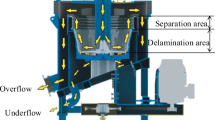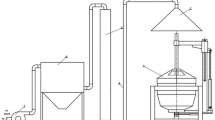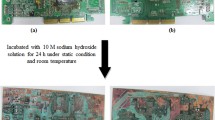Abstract
The current study reports optimization of hammer milling parameters to achieve crushed waste printed circuit boards (WPCBs) of − 16 BSS (British Standard Specification) sieve size. The WPCBs, having 22 wt% copper, have been crushed to − 16 BSS sieve size by means of a hammer mill. The result showed that initial milling takes place rapidly and then decreases gradually. Approximately 94% feed material is ground to − 16 BSS sieve size within 7 min, and further increase in the time does not affect the milling rate. It is also revealed that with the increasing feed rate, lower milling rate is experienced due to the distribution of impact energy among more pieces of WPCBs. Study of the size distribution of milled WPCBs (− 16 BSS sieve size) revealed that it follows the similar trend, and the crushed material is mostly concentrated in − 240 BSS and + 72 to − 52 BSS sieve size range. Further, 50–55% crushed fraction attains + 100 BSS sieve size, while the rest is smaller than this sieve size. Chemical analysis of the crushed material of various size fractions elucidated that a fraction above 100 BSS sieve size is copper rich (43 wt%), while − 100 BSS sieve size fraction has lesser copper because the nonmetals which account for majority concentration in WPCBs are milled to a finer size. Microscopic examinations of crushed fraction showed that copper has metallic luster and ruptured foil-type morphology. The fibrous structure of glass fiber and gray/black-colored polygon morphology of nonmetals were also visible.







Similar content being viewed by others
References
Verma HR, Singh KK, Mankhand TR (2016) Dissolution and separation of brominated epoxy resin of waste printed circuit boards by using di-methyl formamide. J Clean Prod 139:586–596. https://doi.org/10.1016/j.jclepro.2016.08.084
Verma HR, Singh KK, Mankhand TR (2017) Liberation of metal clads of waste printed circuit boards by removal of halogenated epoxy resin substrate using dimethylacetamide. Waste Manag 60:652–659. https://doi.org/10.1016/j.wasman.2016.12.031
Lin KH, Chiang HL (2014) Liquid oil and residual characteristics of printed circuit board recycle by pyrolysis. J Hazard Mater 271:258–265. https://doi.org/10.1016/j.jhazmat.2014.02.031
Verma HR, Singh KK, Mankhand TR (2017) Comparative study of printed circuit board recycling by cracking of internal layers using organic solvents-dimethylformamide and dimethylacetamide. J Clean Prod 142:1721–1727. https://doi.org/10.1016/j.jclepro.2016.11.118
Veit HM, Bernardes AM (eds) (2015) Electronic waste-recycling techniques. Springer International Publishing, Basel. https://doi.org/10.1007/978-3-319-15714-6
Han Y, He W, Li L, Li G, Huang J (2016) Mathematical analysis of the gas–solid fluidized bed separation of metals and nonmetals from waste PCB powders. Powder Technol 295:142–151. https://doi.org/10.1016/j.powtec.2016.03.040
Verma HR, Singh KK, Mankhand TR (2015) A step towards cleaner environment: E-waste recycling. In: Adv. Environ. Friendly Technol. Miner. Process. Met. Extr. (AETMME, 2015), Bhubneshwar, India, pp 21–40
Zhao Y, Zhang B, Duan C, Chen X, Sun S (2015) Material port fractal of fragmentation of waste printed circuit boards (WPCBs) by high-voltage pulse. Powder Technol 269:219–226. https://doi.org/10.1016/j.powtec.2014.09.006
Zhang S, Forssberg E (1999) Intelligent Liberation and classification of electronic scrap. Powder Technol 105:295–301. https://doi.org/10.1016/S0032-5910(99)00151-5
Yoo JM, Jeong J, Yoo K, Lee JC, Kim W (2009) Enrichment of the metallic components from waste printed circuit boards by a mechanical separation process using a stamp mill. Waste Manag 29:1132–1137. https://doi.org/10.1016/j.wasman.2008.06.035
Koyanaka S, Endoh S, Ohya H, Iwata H (1997) Particle shape of copper milled by swing-hammer-type impact mill. Powder Technol 90:135–140. https://doi.org/10.1016/S0032-5910(96)03213-5
Koyanaka S, Endoh S, Ohya H (2006) Effect of impact velocity control on selective grinding of waste printed circuit boards. Adv Powder Technol 17:113–126. https://doi.org/10.1163/156855206775123467
Cui J, Forssberg E (2003) Mechanical recycling of waste electric and electronic equipment: a review. J Hazard Mater 99:243–263. https://doi.org/10.1016/S0304-3894(03)00061-X
Zhang S, Forssberg E (1997) Mechanical separation-oriented characterization of electronic scrap. Resour Conserv Recycl 21:247–269. https://doi.org/10.1016/S0921-3449(97)00039-6
Somasundaram M, Saravanathamizhan R, Basha CA, Nandakumar V, Begum SN, Kannadasan T (2014) Recovery of copper from scrap printed circuit board: modelling and optimization using response surface methodology. Powder Technol 266:1–6. https://doi.org/10.1016/j.powtec.2014.06.006
Jiang W, Jia L, Zhen-Ming X (2008) Optimization of key factors of the electrostatic separation for crushed PCB wastes using roll-type separator. J Hazard Mater 154:161–167. https://doi.org/10.1016/j.jhazmat.2007.10.018
Xie F, Cai T, Ma Y, Li H, Li C, Huang Z, Yuan G (2009) Recovery of Cu and Fe from Printed Circuit Board waste sludge by ultrasound: evaluation of industrial application. J Clean Prod 17:1494–1498. https://doi.org/10.1016/j.jclepro.2009.06.012
Zhang S, Forssberg E, Arvidson B, Moss W (1998) Aluminum recovery from electronic scrap by High-Force® eddy-current separators. Resour Conserv Recycl 23:225–241
Menad N, Guignot S, van Houwelingen JA (2013) New characterisation method of electrical and electronic equipment wastes (WEEE). Waste Manag 33:706–713. https://doi.org/10.1016/j.wasman.2012.04.007
Havlik T, Orac D, Berwanger M, Maul A (2014) The effect of mechanical-physical pretreatment on hydrometallurgical extraction of copper and tin in residue from printed circuit boards from used consumer equipment. Miner Eng 65:163–171. https://doi.org/10.1016/j.mineng.2014.06.004
Cui J, Forssberg E (2003) Mechanical recycling of waste electric and electronic equipment: a review. J Hazard Mater B 99:243–263. https://doi.org/10.1016/S0304-3894(03)00061-X
Kumar V, Lee JC, Jeong J, Jha MK, Kim BS, Singh R (2013) Novel physical separation process for eco-friendly recycling of rare and valuable metals from end-of-life DVD-PCBs. Sep Purif Technol 111:145–154. https://doi.org/10.1016/j.seppur.2013.03.039
Vidyadhar A, Das A (2013) Enrichment implication of froth flotation kinetics in the separation and recovery of metal values from printed circuit boards. Sep Purif Technol 118:305–312. https://doi.org/10.1016/j.seppur.2013.07.027
Eswaraiah C, Kavitha T, Vidyasagar S, Narayanan SS (2008) Classification of metals and plastics from printed circuit boards (PCB) using air classifier. Chem Eng Process 47:565–576. https://doi.org/10.1016/j.cep.2006.11.010
Verma HR, Singh KK, Mankhand TR (2017) Delamination mechanism study of large size waste printed circuit boards by using dimethylacetamide. Waste Manag 65:139–146. https://doi.org/10.1016/j.wasman.2017.04.013
Acknowledgement
The authors express their deep regards to Head, Department of Metallurgical Engineering, Indian Institute of Technology (Banaras Hindu University), Varanasi, India for providing the needful experimental and analytical facilities to carry out this research work.
Author information
Authors and Affiliations
Corresponding author
Additional information
The contributing editor for this article was Bernd Friedrich.
Electronic supplementary material
Below is the link to the electronic supplementary material.
Rights and permissions
About this article
Cite this article
Verma, H.R., Singh, K.K. & Basha, S.M. Effect of Milling Parameters on the Concentration of Copper Content of Hammer-Milled Waste PCBs: A Case Study. J. Sustain. Metall. 4, 187–193 (2018). https://doi.org/10.1007/s40831-018-0179-z
Published:
Issue Date:
DOI: https://doi.org/10.1007/s40831-018-0179-z




